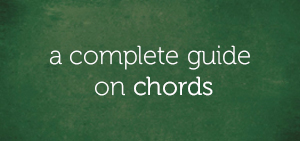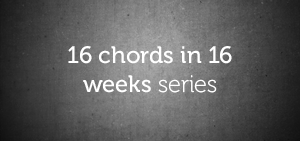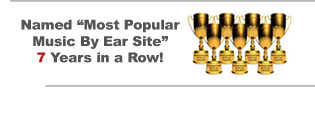If you’re interested in learning how to play exciting worship progressions, this lesson is for you.
Today, we’re going beyond the scale tone chords that are in the major key to the parallel minor key to borrow spicier chords that can be used to create a worship atmosphere during the worship segment of the church service.
Now, because I don’t want to assume that you’re already familiar with the concept of borrowed chords, we’re starting out with a concise explanation on what borrowed chords are.
“What Does It Mean To Borrow Chords?”
A borrowed chord is a scale tone chord in the parallel minor key that is played in the prevalent major key.
For every major key, there’s a parallel minor key sharing the same tonic with it. The key of C major:
…has its tonic as C:
…so, the minor key that has C as its tonic is the parallel minor key and that’s the key of C minor:
If both keys are placed side-by-side:
C major:
C minor:
…you’d see that both the prevalent major key (which is the key of C major) and the parallel minor key (which is C minor) share the same tonic (which is C.)
“Here’s How To Borrow A Chord”
The following chords are the 2-chords in the key of C major and C minor respectively:
D minor triad (2-chord in the key of C major):
D diminished triad (2-chord in the key of C minor):
In the key of C major (which is the prevalent major key):
…the 2-chord in the key of C minor (which is the D diminished triad):
…can be borrowed from the parallel minor key (the key of C minor):
Attention: Every other chord in the parallel minor key can be borrowed in the same vein.
A Short Note On Worship Progressions
There are unique chord progressions that can be used to transition into or out of the worship segment of the church service and they are known as worship progressions.
Although there is no theoretical basis for the use of the term “worship” to describe these progressions, they have been long associated with the worship segment of the service and have come to be known as worship progressions among musicians.
The importance of worship progressions cannot be over-emphasized and this is because they literally create a flow of rivers of instrumental worship and creates the mood or atmosphere for a better worship experience.
Using the worship progressions you’re about to learn in the next segment, you can add an extra dimension to the church service and they are spicier because the chords you’ll be learning are borrowed.
“Are You Going To Worship With Borrowed Chords?”
Well, if you’ll have to borrow chords to play more exciting worship progressions, please do.
Exciting Worship Progressions Using Borrowed Chords
All the progressions in this segment are to be played over the tonic bass note in the key. In the key of C major:
…the tonic bass note is C:
…so, we’ll be playing all the chords over the C bass note.
Attention: Each of the chords should be played over 2 or 4 counts each
Worship Progression #1
From the C major triad:
…this worship progression progresses to the F minor triad:
…which is the 4-chord in the parallel minor key.
“Check It Out..”
C major triad:
F minor triad:
Suggestion: Each of the chords should be played over 2 or 4 counts.
Worship Progression #2
In this second worship progression, we’re adding the G minor triad to the progression we just learned. In worship progression #1, we progressed from the C major triad:
…to the F minor triad:
Adding the G minor triad (the 5-chord that is borrowed from the parallel minor key):
…produces worship progression #2.
“Here You Are…”
C major triad:
F minor triad:
G minor triad:
F minor triad:
Suggestion: Two or four counts are recommended for each of the chords.
Worship Progression #3
This worship progression sounds like worship progression #1.
Progressing from the C major triad to the 2-chord in the parallel minor key (which is the D diminished triad):
…produces this chord progression.
“Check It Out!”
C major triad:
D diminished triad:
Worship Progression #4
In this worship progression, we’re progressing from the C major triad to the 7-chord in the parallel minor key (which is the Bb major triad):
“Check It Out!”
C major triad:
B major triad:
Worship Progression #5
From the C major triad:
…this worship progression progresses to the Bb major triad:
…which is the 7-chord in the parallel minor key, then to the F minor triad:
…which is the 4-chord in the parallel minor key.
“Check It Out..”
C major triad:
Bb major triad:
F minor triad:
Suggestion: Each of the chords should be played over 2 or 4 counts.
Final Words
Using the progressions covered in this lesson, I guarantee that you can take your church musicianship to the next level and basically do more in the worship segment.
Can borrowed chords be used in other segments of the service like Praise, Offering, Communion, etc?
Well, I’ll give you an answer to that in subsequent lessons.
See you then!
Chuku Onyemachi
Latest posts by Chuku Onyemachi (see all)
- The Formation Of Diminished Seventh Chords Used To Be Challenging Until I Did This
- How To Form Seventh Chords In Two Shakes Of A Dog’s Tail Using Third Intervals And The Circle Of Fifths Chart
- I Played The 13sus4 Chord And This Happened…
- How To Build Seventh Chords Like An Architect Using “Foundation And Structure” Concept
- This 4-Week Plan Will Help You Master All The Major Scales







Comments on this entry are closed.